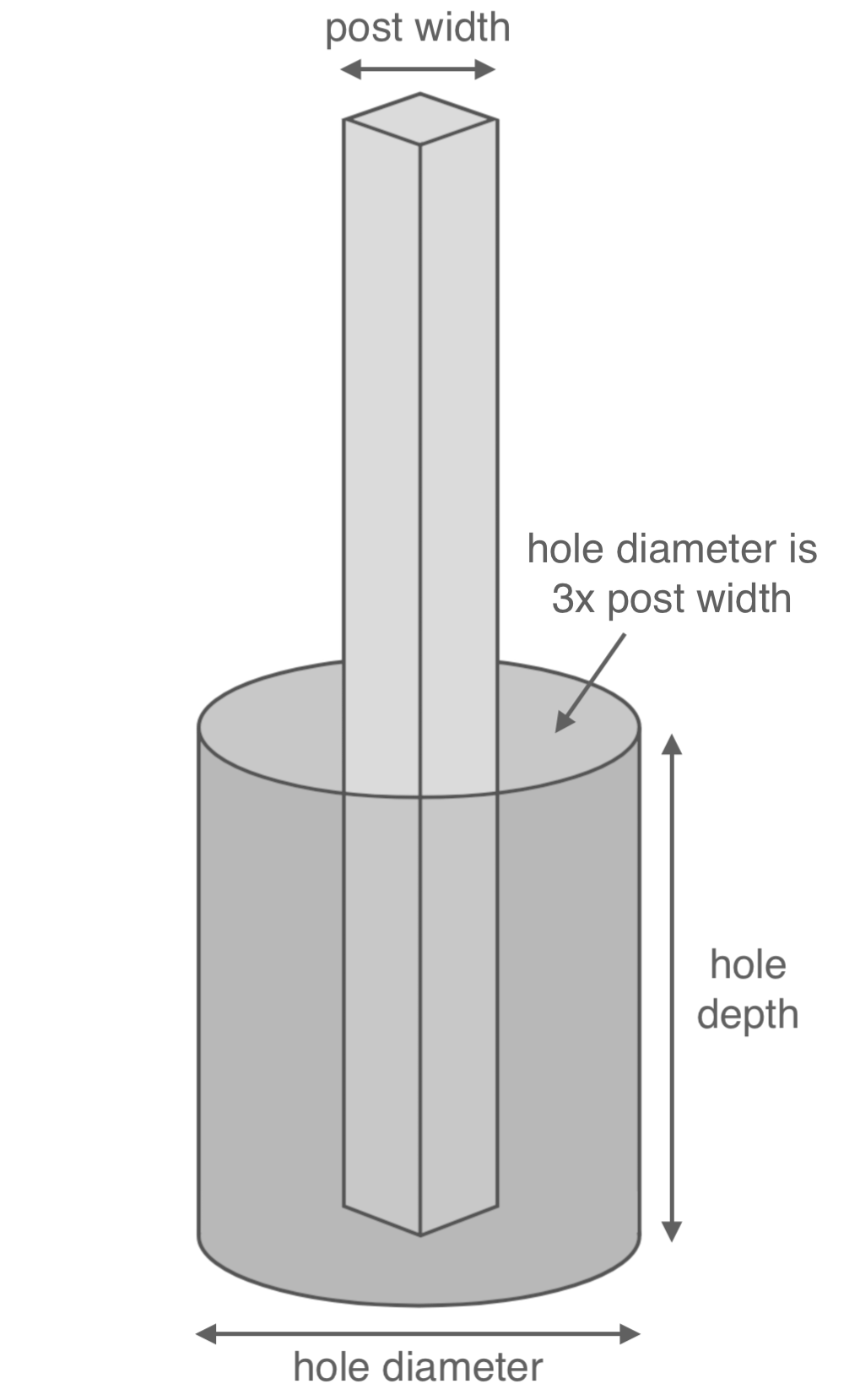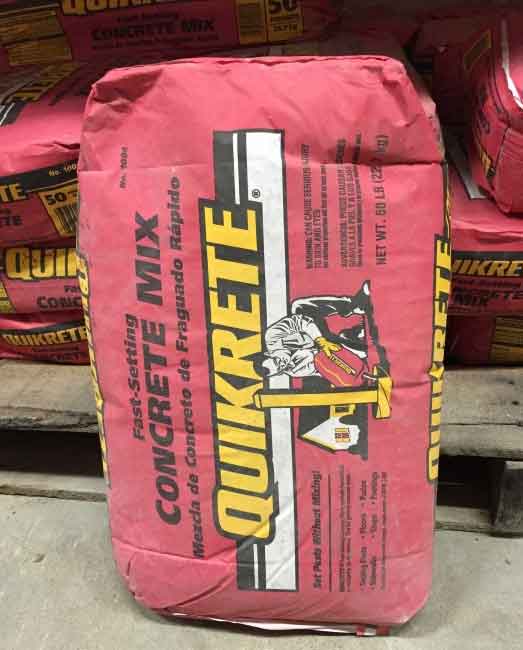Post Hole Concrete Calculator
Calculate how many yards or how many bags of concrete you’ll need for a set of post holes by entering the post diameter and hole size.
If you’re not sure what size hole to dig, a rule of thumb is to use a hole diameter three times the post diameter and ⅓ as deep as the post height.
Results:
| Cubic Yards: | |
| Cubic Meters: |
Pre-mixed Bags
| 50-lb Bags: | |
| 60-lb Bags: | |
| 80-lb Bags: |
Estimated Concrete Cost
On this page:
- Post Hole Concrete Calculator
- How to Use the Post Hole Calculator
- How Much Concrete Do You Need Per Fence Post?
- Post Hole Volume Formulas
- Calculate Concrete Volume
- Example Fence Post Concrete Calculation
- How Many Bags of Concrete Do You Need Per Fence Post
- Dry, Pre-Mixes Bag Concrete Yield
- Tips For Ordering Concrete
- Type of Concrete and its Proper Installation
- Additional Costs
- Additional Concrete
- Allocate Enough Time
How to Use the Post Hole Calculator
Fence posts must be sunk into the ground and secured using concrete in order to create a stable and long-lasting fence. Concrete can be purchased ready to pour in large amounts or in dry bags for smaller amounts.
To calculate the amount of concrete you will need to set fence posts, use this post hole estimator. Enter your post and hole dimensions in any units, and the calculator will give you the results in cubic yards and the number of pre-mixed, dry bags of concrete needed.
Fence posts must be set into the ground at a depth that is a minimum of ⅓ the total height of the fence. For a 6′ fence, this would mean the hole must be a minimum of 2′ deep. The width of this hole should be three times the width of the post. If your fence posts are made of 4″ x 4″ boards or are round with a 4″ diameter, these have an actual width or diameter of 3-½”. This would make the width or diameter of the hole 10.5′.
It’s a good idea to order roughly 10% additional material to account for settling and spillage. If you don’t have many posts to set, it may be more cost-effective to purchase dry concrete, mix it with water, and set the posts yourself.
If, however, you need a cubic yard or more of concrete total, you may find it easier to have it delivered pre-mixed and ready for pouring.
Concrete contractors can provide estimates for delivering and installing cement for your post project.

How Much Concrete Do You Need Per Fence Post?
Concrete is sold ready-mixed (and usually delivered) by the cubic yard or in dry, pre-mixed bags by weight.
To calculate how much concrete you need, you need to know the post size you are going to use and how many posts you are installing. Your post diameter if it is round, or length and width if it’s square, and height determine how big each hole needs to be.
As stated above, fence post holes should be three times the diameter or width of your post and ⅓ as deep as your fence is tall.
First, you need to calculate the volume for the post hole. Then calculate the volume for the part of the post that will be submerged in the hole. Make sure all your units of measurement are the same, meaning that if you measure the width in inches, you should also measure the length and depth in inches.
To easily use the table above, convert your units to feet if they aren’t already. Use our calculators to quickly convert inches, yards, or meters to feet.
Or, if you are using inches for your calculations, you can convert to cubic yards by dividing the inches by 46,660 – the number of cubic inches in a cubic yard.
Post Hole Volume Formulas
Your post holes may be round, meaning cylindrical, or they may be rectangular, depending on how the post hole is dug. Likewise, your post itself may be round or square in shape.
Depending on the shape of the post and the hole, this may change the formula used to calculate the volume. Use the following formulas to calculate volume. For other types of round holes, use our cylinder cubic yardage calculator.
Rectangle:
volume = length × width × depth
Cylinder:
volume = radius2 × π × depth (π = 3.14)
Calculate Concrete Volume
Unlike a typical concrete pier, you need to account for the space that the post takes up in the hole when estimating. So, with the volume of the submerged post and the volume of the hole figured out, subtract the post volume from the hole volume, and you will have the volume of concrete needed for each hole.
Simply multiply that amount times the number of posts to get the total quantity. Don’t forget to add in some extra for spillage and waste.
If you have multiple different size post holes to fill, calculate each set with matching dimensions separately, then add the totals together.
Example Fence Post Concrete Calculation
Let’s use an example to illustrate what we covered above. Let’s assume you’re installing a 6-foot high fence, where 2 feet of the post will be in the ground, and you will need twenty (20) 4″ nominal round posts.
Note that 4″ posts are actually 3 ½ in diameter. Use the formulas above for volume.
Calculate the post volume
Divide by 12 to convert the post diameter to feet:
3.5″ ÷ 12 = 0.2917′
Next, find the radius (½ of the diameter):
0.2917′ ÷ 2 = 0.1458′
Finally, use the cylinder formula to find the volume of a round post:
(0.1458′)² × π × 2′ = 0.1336 cubic ft.
Calculate the hole volume
Find the hole radius (3x post radius):
3 x 0.1458′ = 0.4374′
Find the volume of the post hole using the cylinder volume formula:
(0.4374′)² × π × 2′ = 1.2026 cubic ft.
Calculate concrete volume
To find the concrete needed, start by subtracting the volume of the post from the volume of the hole:
1.2026 – 0.1336 = 1.069 cubic ft. per post
Then multiply by the number of posts to find the total amount of concrete needed for the project:
1.069 cubic ft × 20 posts = 21.38 cubic ft.
Finally, convert it to cubic yards:
21.38 cubic ft. ÷ 27 = 0.79 cubic yards
Hint: you can also use a concrete calculator for this step.
Most people find it easier to find cubic feet first, then convert it to cubic yards; if so, divide the cubic footage by 27.
If you are using square posts of the same measurements, the formula will look like this:
Divide by 12 to convert the post width to feet:
3.5 ÷ 12 = 0.292 feet
Take the length and width of the post and multiply those times the depth of the post to get the cubic volume of the post:
0.292′ × 0.292′ × 2′ = 0.17 cubic feet
Calculate the hole volume using 3 times the width of the post or 10.5″ or 0.88 feet:
0.88′ × 0.88′ × 2′ depth = 1.55 cubic feet
Subtract the post volume from the hole volume:
1.55 – 0.17 = 1.38 cubic feet per post hole
Multiply times the total number of posts:
1.38 × 20 posts = 27.6 cubic feet
Add 10% for waste = 30.36 cubic feet
Divide by 27 to get the number of cubic yards – 1.12 cubic yards of concrete needed.
How Many Bags of Concrete Do You Need Per Fence Post
Most concrete suppliers will not sell fractions of a yard of concrete, though it is worth asking about. So, in many cases, you will need to purchase bags.
For the first example above, we can use the table below, to find the number of bags. In this case, you would need to buy at least eight 80 lb. bags and one 40 lb. bag (yielding a total of 5.1 cubic feet) of concrete to allow enough for extra.

Dry, Pre-Mixes Bag Concrete Yield
The following table shows the approximate yield of mixed concrete for common bag weights.
| Bag Concrete Weight | Mixed Concrete Yield (approximate) |
|---|---|
| 40 lb (18.1 kg) | 0.30 cu ft (8.5 L) |
| 60 lb (27.2 kg) | 0.45 cu ft (12.7 L) |
| 80 lb (36.3 kg) | 0.60 cu ft (17 L) |
Tips For Ordering Concrete
Consider these tips to ensure your concrete installation goes smoothly.
Type of Concrete and its Proper Installation
The type of concrete you use and its application will vary depending on your climate. Colder temperatures need longer curing times; sandy soils need different shaped holes; more extreme freeze/thaw cycles need higher strength concrete than more temperate regions.
Your concrete supplier can advise you on the proper mix to use for your project and region.
Additional Costs
For ready-mix concrete delivery, there are typically additional fees for delivery, weekend service, small loads, and overtime for long unloading times. Discuss these issues with your concrete supplier ahead of time so that you have a clear understanding of costs and can plan accordingly.
Additional Concrete
Order extra concrete (overage) for your project. The amount of overage you plan for will vary based on your quantity, but plan for at least 10% overage to accommodate spillage, settling, and grading inconsistencies.
This will save you from a bad pour (concrete installed in parts resulting in a separated, weak mass) in the event that your estimates are even slightly off.
Allocate Enough Time
Finally, digging can be hard, time-consuming work. Allow plenty of time to dig all the post holes for the project before the concrete is delivered or mixed.
Mixed concrete that must sit before being poured into place can partially or even fully set. This can result in significant waste from hardened, unused concrete or create air pockets and compromised strength from pouring concrete that is too thick.


